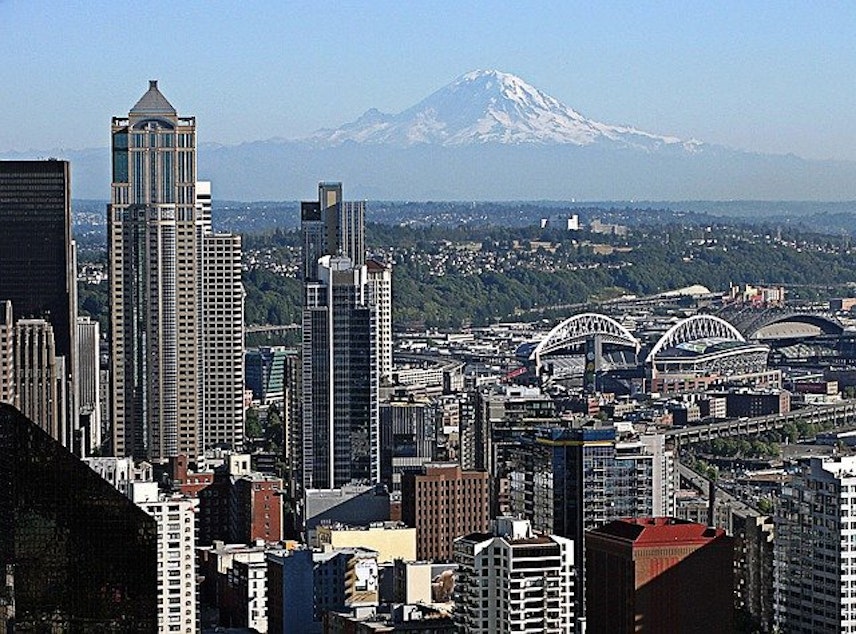Pondering I-135, Seattle's social housing proposal: Today So Far

Ballots for Seattle's special election went out last month and are due back by Feb. 14. There is only one issue on the ballot: Initiative 135 — social housing.
This post originally appeared in KUOW's Today So Far newsletter for February 6, 2023.
You've likely heard about the effort to create social housing in Seattle over the past year. It missed an opportunity to be on November's ballot, but it's back. As Axios' Melissa Santos explained to Seattle Now this morning, social housing is a form of affordable housing, but it doesn't quite work the same. The end goal is the same, however, which is to create more housing and open up more affordable options for people in town.
For an adequate conversation about affordable housing in Seattle, you need to ditch your preconceptions about "affordable" and "housing," especially if you haven't had to navigate this sort of thing around here. It's not like the lofty expectations set up by your average TV show, like "New Girl," where we're asked to believe that, despite plumbing problems, a spacious, multi-bedroom affordable apartment is out there for a bartender, a teacher, a marketer, and someone merely discovering their path in life. Let alone an apartment that is located in the heart of the city with ample parking.
While we're at it, sorry Carrie Bradshaw, a writer could not live on the Upper East Side. I doubt even Frasier could afford that Seattle view. And honestly, I'm not certain that fry cook SpongeBob could even afford an entire pineapple on prime Bikini Bottom property. Kimmy Schmidt's closet is probably the best representation of making it work in a city like Seattle.
RIPPLE EFFECT: Seattle's housing woes pushing people further out
Which brings us to social housing, the latest attempt to fill in some affordable housing gaps around here.
"What makes it 'social housing' is a sort of intermingling of different income levels. These wouldn't be buildings where everybody who lives there makes under 30% of median income, it's up to 120% of median income," Santos said. "All those folks can live in there, and the deal is each of them pays rent that is a portion of their income, a maximum of 30% of their income. If you make more, you pay more. The lower-income people pay much less."
Make a note of what Santos says here about allowing for a range of income levels, from low to high. That brings up a curiosity that I'm going to point to later.
I-135 doesn't immediately create social housing. Rather, it creates an office within city hall that will pursue studies and create the program. Funding for this initial effort only covers 18 months. From there, additional, long-term funding will be required for this office to buy property, build housing, and operate it.
Funding is one part of this social housing proposal that is a gray area. A source of funding is absent from the initiative. Santos speculates that this was by design to give it better chances of being approved by voters. Such funding could come from the city's budget, new taxes, loans, etc. (my Dyer prediction is that it will be a some type of new tax). Other specifics remain unknown, such as estimates on how many social housing units could ultimately be produced in Seattle.
What is known is that a public developer (a new office in Seattle City Hall) could build affordable housing on public property. It could also buy property to develop. New social housing will be required to be green and energy efficient. Existing housing that is purchased will be upgraded. Each building would have a governing board comprised of a majority of residents.
RELATED: 2023 housing strategies proposed by Seattle's top CEOs
Supporters tell KUOW that initial efforts would likely be purchases of existing housing. Tenants will not be kicked out; rather, the social housing system will be phased in. New residents would be chosen via a lottery system. Real Change and the Low Income Housing Institute are supporting I-135. Also, a group of health care workers.
Low-income and homeless advocates, and others like The Seattle Times oppose the idea. There is a concern that I-135 would set up a level of competition for other homelessness and low-income housing organizations. One opponent told KUOW that there are already affordable housing organizations up and running around Seattle, which greatly appreciate the surge in funding created by I-135.
“I’m not gonna say it is the solution, but it is a solution..." I-135 supporter Dawn Dailey told KUOW.
Both arguments appear to have some logic. Social housing is a form of public housing, which has a bad reputation in the USA. Our region's affordable housing is pretty weak. But I keep going back to something Shaina Shepherd recently told KUOW. Shepherd, a social housing proponent, said that she has been on an affordable housing waitlist for more than three years. This is not the first time I've heard of this experience in Seattle. Even if you can get past the waitlist, that just gets your foot in the door. You then have to check a series of boxes. Affordable housing is not easy to access around Seattle.
On top of that, the concept of "affordable housing" is debatable. It's not actually about housing that an average person can afford. It really comes down to a formula, which allows very low-income residents in. But as any regular, working resident around here is aware of, true affordable housing does not exist in Seattle. That means housing a cook, sales person, office worker, teacher, janitor, grocery employee, health care worker, and all the people you depend on to make this community thrive, cannot afford to live locally. There is no "affordable" housing for them. You know that old advice your parents kept telling you: "Spend a third of what you earn on housing." That stopped being relevant in Seattle a long, long time ago — probably somewhere around the time Don Draper was able to afford apartment 17-B in that New York high rise.
I can't tell you if social housing will work or not, or if it is a good idea. But I can offer a question to ponder.
The aspect that intrigues me most about I-135 is the potential to have a range of income levels living together as neighbors. Right now, it's more likely that high earners are clumped in their corners of Seattle, and low earners are in their own corners.
How beneficial could it be to have different income levels and working backgrounds intermingling? Granted, I'm the sort of neighbor who you're lucky to get a head nod out of while passing in the hall. But it's worth wondering if doing something other than isolating different economic groups around the city could alleviate some issues. This could produce a form of networking, for opportunities, or at least understanding about a corner of society folks would otherwise know nothing about, yet make decisions for through their votes and wallets. Perhaps actually putting that bartender, teacher, marketer, and even someone discovering their path in life in the same housing could offer some benefits, if not at the very least, some entertaining situational comedy.
Check out Seattle Now's conversation with Axios' Melissa Santos here.
Check out the arguments around social housing here.
AS SEEN ON KUOW

Kyle Nguyen, 7, rests on a bench as the Mak Fai Dragon and Lion dancers get ready for several performances ahead of the lunar new year celebration on Saturday, February 4, 2023, in Seattle’s Chinatown-International District. Hundreds gathered to welcome the Year of the Rabbit during the lunar new year celebration in Seattle's Chinatown-International District on Saturday. Check out a photo gallery of the celebration here. (Megan Farmer / KUOW)
DID YOU KNOW?
Many folks don't realize that much of the everyday tech we rely on originated with government agencies, such as NASA or DARPA (Defense Advanced Research Projects Agency). Since these advancements and innovations are technically public, it's pretty easy pickings for private parties to play with. Long story short, DARPA dabbled and today we have the internet. Or, again DARPA, invented a computer voice interaction program, and now we have Apple's Siri.
The reason I lay all that out is because of Gladys West. She's a big reason why we have GPS today, and why your phone can guide you to the nearest teriyaki joint (it can map out other places, too).
Born in 1930, West grew up in rural Virginia amid a community of sharecroppers. A scholarship to college put West on a new path. She earned a degree in mathematics in 1952, then a Master of Mathematics degree in 1955, and went to work for the Naval Proving Ground in Dahlgren, Virginia, in 1956. She was one of four Black employees at the site. This is where she met her husband, another mathematician, Ira West. Gladys West put her mathematic skills toward computing and satellites. Specifically, satellite geodesy, which is the science of measuring the Earth. In the 1970s and 1980s, she programmed an IBM computer to carry out calculations, using satellite data, to create a model of the Earth's shape and monitor oceanic conditions. It was extremely complex. Whether she knew it at the time or not, this innovation is the what the Global Positioning System (GPS) is built upon.
As impressive as that single contribution to our daily lives is, West's achievements don't end there. During her time working for the Navy, she continued her education and earned a second master's degree in public administration. After she retired in 1998 (and while recovering from a stroke), she went back to school to earn a PhD in public administration at the age of 70. Recognition for her contributions and innovations did not come until later in her life. Once uncovered, West was inducted into the U.S. Air Force Hall of Fame in 2018. Also in 2018, she was awarded Female Alumna of the Year by HBCU digest, and the Virginia General Assembly formally recognized her for the development of GPS.
Despite her major contribution to GPS, an innovation that influences our modern world, West reportedly still prefers to use a paper map.
ALSO ON OUR MINDS

Gen Z's political power: new data gives insight into America's youngest voters
A new report found that Gen Z primarily relies on social media for news instead of more traditional media platforms — raising questions for strategists and organizers alike over how to engage the country's youngest adults in politics. Generation Z, is still just getting its feet wet in politics, since the oldest members of the generation turn 26 this year. Along with millennials, Gen Zers turned out in historically high numbers for a midterm election, second only to the 2018 election.

